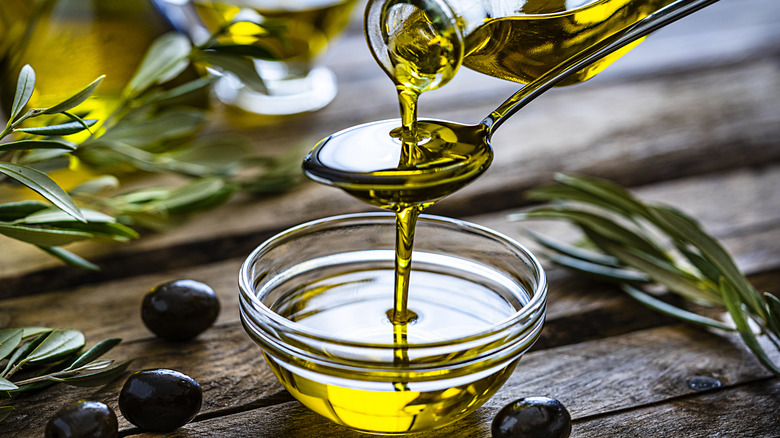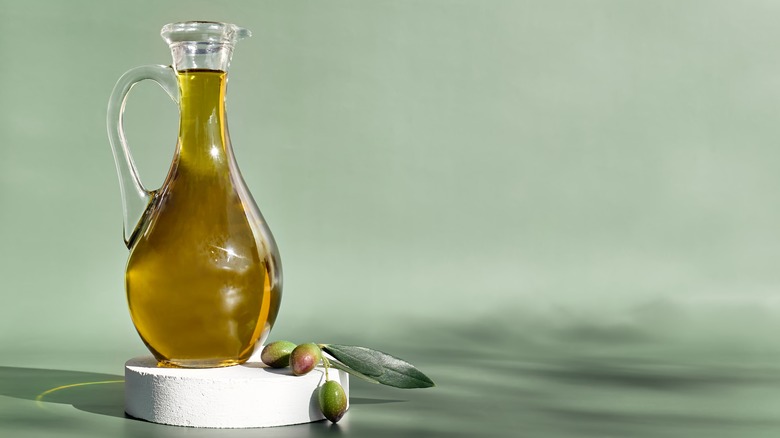What To Know When Shopping For Olive Oil To Find The Best Bottle Every Time
Olive oil is often considered the holy grail of cooking oils, and for good reason – it's rich in antioxidants, has anti-inflammatory properties, and protects against heart disease. This popularity comes at a price, though. Quality olive oil can be expensive. If we're going to shell out the cash to get the good stuff, we want to make sure that we're getting the premium quality we're paying for.
That's why we reached out to Katerina Mountanos, certified olive oil sommelier and founder of Mediterranean-rooted olive oil and lifestyle brand Kosterina, to see if she had any helpful tips on how to tell premium olive oil from the frauds. She was a treasure trove of information, eager to share her love of all things olive.
We discussed two different ways to identify good quality extra virgin olive oil (EVOO): while you're still at the grocery store and once you're home with an open bottle. If you can taste the olive oil, it's not hard to figure out if you like it or not. But it's a whole lot better if we know good from bad before we actually pay for the stuff instead of guessing and getting stuck with a subpar product for however many months it takes to work through it. We covered both so you'll be prepared for any situation.
Signals on the shelf
There are four things to keep in mind: packaging, labels, the date, and price. "You'll only want to buy olive oil that's packaged in opaque glass bottles or aluminum tins – never plastic!" says Mountanos. "Olive oil is corrosive to plastic and you'll likely end up with microplastics in your oil." You'll also want the bottle to be opaque because "light (and heat) are the enemy to good EVOO."
"Look at the bottle's label for a 'batch date,' 'bottled date,' or 'harvested date' that's within 18 months," Mountanos told us. "If it only has an expiration date and nothing else, you might want to consider not purchasing it because you could be purchasing olive oil that has been produced or bottled years before." As for labels, they "should always say 'extra virgin,' and avoid any terms like 'pure,' 'light,' or 'olive pomace oil' — that means it's been chemically refined."
Although you may be hoping that the best olive oil is the cheapest, that's sadly not the case. "Early harvest olive oil (which has the highest level of healthy polyphenols) is oil squeezed from the olive before the olive is ripe. An unripe olive yields much less olive oil but much higher quality oil. Since the manufacturer yields much less oil it makes the 'juice' more expensive." You may not need to buy the most expensive option, but "if it's cheap, it might not be genuine olive oil—so think of it as an investment in your health."
That premium taste
Now that you've splurged on the good stuff, it's time to take it home and taste it. Mountanos walks us through how an olive oil sommelier does it. "To taste olive oil like an expert you'll want to pour EVOO in a small glass and warm the glass in your hand a bit. Swirl it around and bring the glass right to your nose and take in the aromas. True olive oil should smell fresh, like grass or something fruity. Avoid something that smells musty or rancid, or even odorless. In addition to smell, when you're tasting olive oils, you should recognize hints of grass, fruit, and almond."
Fresh grass and fruit sound great, but is there anything else we should be looking for to identify quality? There sure is. "It should taste smooth but also a little bit bitter," she says. "You should get a bit of a slight burn or pepperiness at the back of your throat – those are the polyphenols (or antioxidants) that have incredible health benefits. The EVOO will not taste bitter on food, it will just add incredible depth of flavor to anything you're pouring it on."
There you have it. You've just gotten your first crash course on becoming an olive oil sommelier, fully prepared to stare down the enormous olive oil section at your local grocery store until you find your perfect match.


